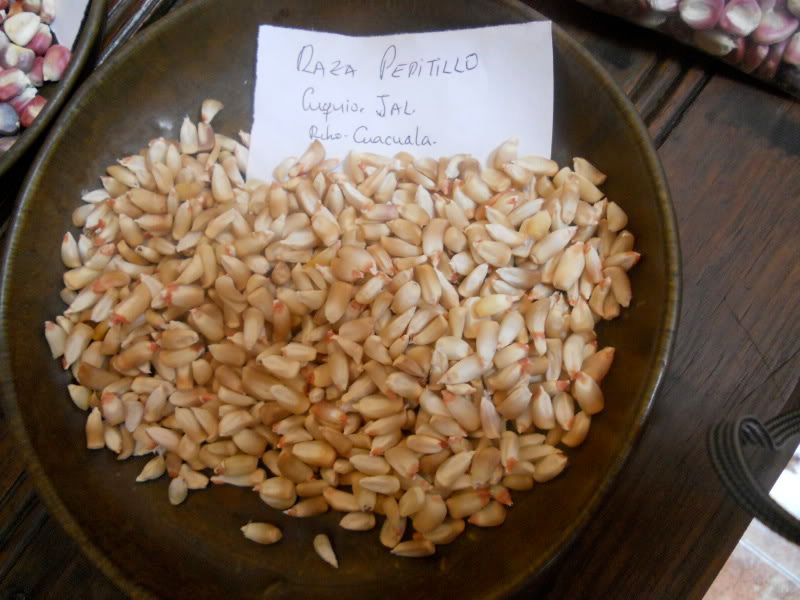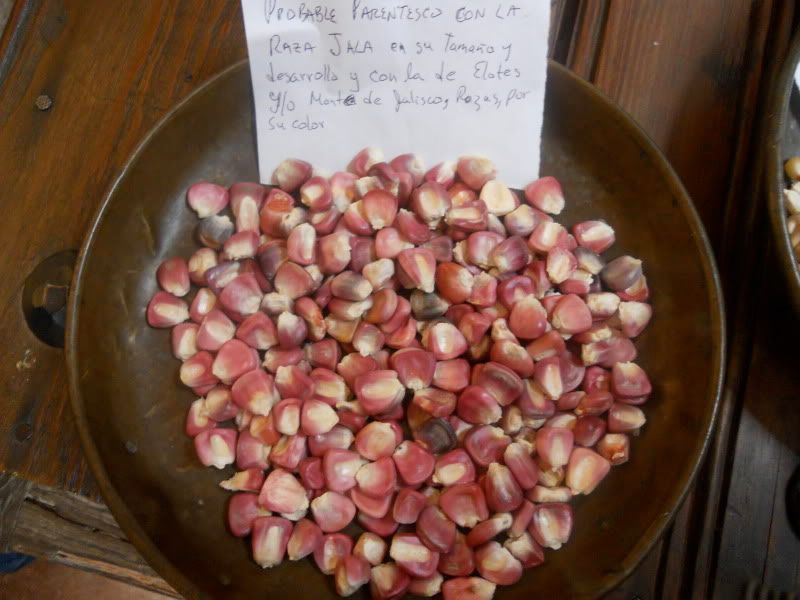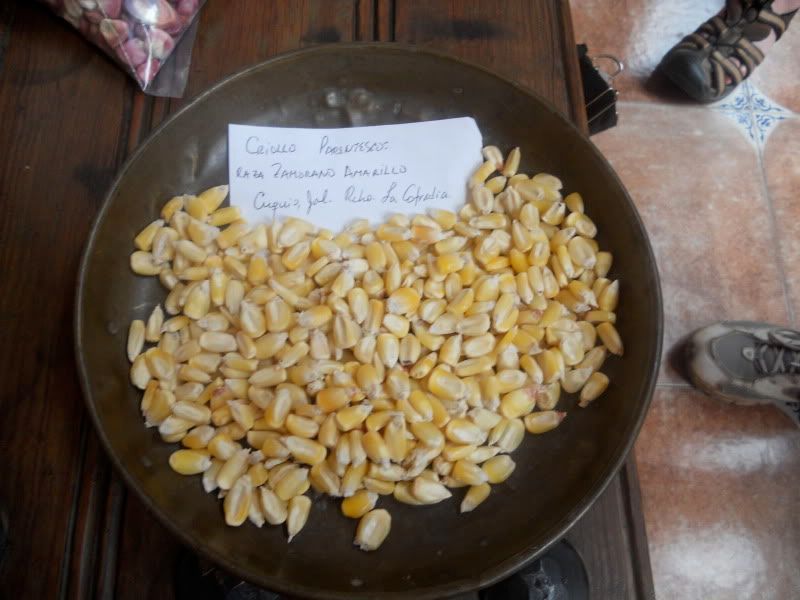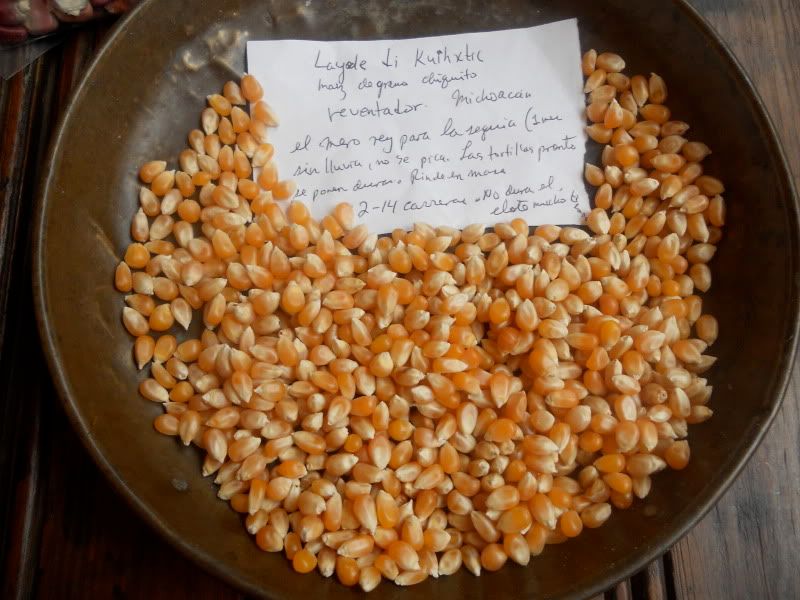
Ann Lopez talks to Juan Alba
If reading about the people I've visited inspires you to help, you can donate to the Center for Farmworker Families. Every penny given goes directly to these families for clothes, shoes, food, school supplies, and more.
During our conversation with Juan, we realized that it was important to get everyone in our group up to speed on the biology of corn. Corn was domesticated from a plant found in Mexico called teosinte. In other words, it evolved from teosinte to what we know as corn, but its evolution was guided by human selection based on traits that we found desirable in the plant.
Corn can vary in a number of different ways - its height, kernel color, kernel size and shape, length of the corncob, number of rows of corn kernels, drought tolerance, rate of growth, resistance or susceptibility to pests and disease, etc. In the U.S., we grow various varieties of corn for different uses: popcorn, sweet corn, dent corn (for animal feed and industrial uses), and ornamental varieties of corn to decorate our homes at Thanksgiving.
I'm not quite sure yet if traditional Mexican maiz criollo falls into these same classifications. I should have asked - but didn't - whether Mexicans plant one variety to harvest as elotes (corn on the cob) in September and a different variety to harvest for animal feed and tortillas in December. I do know for sure that they are quite specific about which type of corn they use for posole.
The corn plant is in the grass family. At a certain point in its development, a corn plant produces a tassel on top. That's the male part of the plant. If you look, you'll see the tassels are covered in anthers bearing pollen. A few days later, lower down on the plant, you will see the silks emerge. These are the same silks that we remove when we eat corn on the cob, and they are the female parts of the plant. Each silk corresponds to one corn kernel on the cob, and for that kernel to form, that silk must be pollinated by the pollen from the tassels.
Typically, corn is wind pollinated (i.e. the wind blows the pollen from the tassels to the silks). However, you need to grow a certain critical mass of corn to rely on the wind to pollinate your silks for you. If you are growing fewer than about 5 rows of corn, it's up to you to pollinate the corn yourself if you'd like to have anything to eat later on. And, as you can imagine, corn is quite promiscuous, blowing its pollen every which way in the wind, pollinating any corn plant nearby without regard to whether that corn plant is a different variety or not. (Imagine a purebred cocker spaniel humping everything in the street it comes across - boxers, poodles, chihuahuas - producing mutts as offspring.)
To make sure that your corn plants are only pollinated by corn pollen from the same variety, you must either plant each variety quite far from one another, plant them at different times so that when one is producing pollen, the others aren't showing silks, or cover the silks of each plant so that they can't be accidentally pollinated by the wrong pollen (and hand pollinate them so you know they WERE pollinated by the right pollen).
There are a few different types of seeds that we spoke about in our conversation. First, are open-pollinated seeds. These are seeds that will produce plants similar to the generation before them. The seeds you collect from plants grown from open-pollinated seeds can be saved and planted. Heirloom seeds are open-pollinated, as are all of the traditional varieties of maiz criollo.
Then, there are hybrid seeds. These seeds come from two genetically pure lines which are crossed to produce "hybrid vigor" (imagine crossing two breeds of dog, like a pug and a beagle, to produce a hybrid puggle). In a hybrid, the dominant genes are expressed and the recessive genes are not. However, in the next generation (i.e. if you save the seeds produced from your corn plant grown with hybrid seeds bought from Monsanto or DuPont) will not necessarily produce plants identical to their parents. In other words, a pug and a beagle can reliably produce a puggle, but two puggles mating cannot because it's possible for the offspring to receive 2 recessive genes and express recessive traits.
And, last, there are genetically engineered seeds, which are typically also hybrids that have had genes from other species added to their DNA. For corn, the commercially available varieties of GE seeds are either resistant to the herbicide glyphosate, sold under the brand name Roundup (known in Mexico as "faena"), or they produce an insecticide called Bt in every cell of the plant. Often both of these traits are engineered into the same seeds, making the seeds both Bt and Roundup Ready.
That gets us to the beginning of our conversation with Juan Alba, a Mexican agronomist working to conserve all of the various varieties of maiz criollo, developed in Mexico over thousands of years by peasants and now at the risk of extinction. He brought several samples of maiz criollo to show us:








Juan's father was a campesino, like the people we've been visiting in the ranchos during this trip. For much of his life, Juan was a campesino as well, beginning at age 5 when he started collecting camote (a wild tuber) and at age 6 when he began working in the fields with a horse and plow. His father had 3 hectares where they produced fruit, vegetables, and flowers. Each year, they had no idea how much they would produce, how much money they would earn, or whether they would be able to earn enough to make it through another year. This motivated Juan to go to school to become an agronomist. He wanted to use his knowledge to help his family and other poor campesinos.
Juan favors rural development to help the poor and, to the extent possible, organic agriculture (it seems to me that he's not a purist on this). Juan described to us the soils of Jalisco, which are quite poor and very acidic (with pHs as low as 4.2). The soils are very heavy clay and water does not penetrate them well. Juan said that even if one uses urea fertilizer, as most farmers in this area do, one will only get a yield of about 2 metric tons per hectare. Likewise, if you apply only compost, you'll get corn that's more nutritious, but you'll still wind up with only 2 metric tons per hectare.
Instead of applying 1500kg/ha of urea, Juan recommends a compost made with a mix of worm castings, fish hydrolysate, soy flour, and crop residue, combined with 200kg/ha of ammonium phosphate. Together, he says this mixture is three times stronger than the urea farmers typically use around here, resulting in harvests of 7-10 metric tons/ha. Typically, chemical fertilizers kill the life in the soil. However, using Juan's method, he says the large amount of compost mixed with the small amount of chemical fertilizer will neutralize the effects of the chemical fertilizer to keep it from killing the organisms in the soil.
I asked if he thought raising the pH of the soil with lime would help. He replied that he believes that adding "cal" (calcium carbonate, the active ingredient in lime) in addition to the compost and ammonium phosphate would be a good idea. I also asked if he used cover cropping. He replied that the soil is never "bald-headed" (i.e. bare) because it is always covered with a crop or a cover crop using his methods. Last, he told us that he only uses pesticides or herbicides in rare occasions and only when the soil is healthy enough that it can recover.
He is hoping that the grave situation farmers find themselves in, either losing money or not even producing enough to feed their families for the year, will induce more people to try his methods. He's tried teaching these methods to some of the more progressive farmers, and so far there are 25 corn producers who have adopted his ideas.
The other important point Juan made was about tall cornstalks blowing over in the wind ("lodging"), reducing a farmer's overall yield. Maiz criollo is taller than hybrid and GE varieties of corn, and it produces longer mazorcas (corn cobs). Because of this, maiz criollo is far more likely to lodge, reducing a farmer's yield significantly. But, he said, it does not have to be like this.
Uneducated campesinos tend to select which seeds to save based only on the size of the mazorcas and not based on the properties of entire plant. Instead of saving the seeds of the biggest mazorcas, they should save seeds only from plants with stalks that are strong enough that they don't lodge. In several generations of selecting for this, they will be able to remove the problem of maiz criollo lodging and reducing their yields. (I asked if another possibility would be planting rows of trees as windbreaks, and he said he's trying this but he doesn't have results yet.)
Our conversation with Juan lasted nearly 4 hours, so at last we let him go. He joined us again the next day, and we've exchanged email addresses as well. Hopefully he will be able to play a role in helping preserve maiz criollo and promoting ecological agriculture (or something very close to it) while also ensuring that the people who adopt his methods have enough to eat.
No comments:
Post a Comment